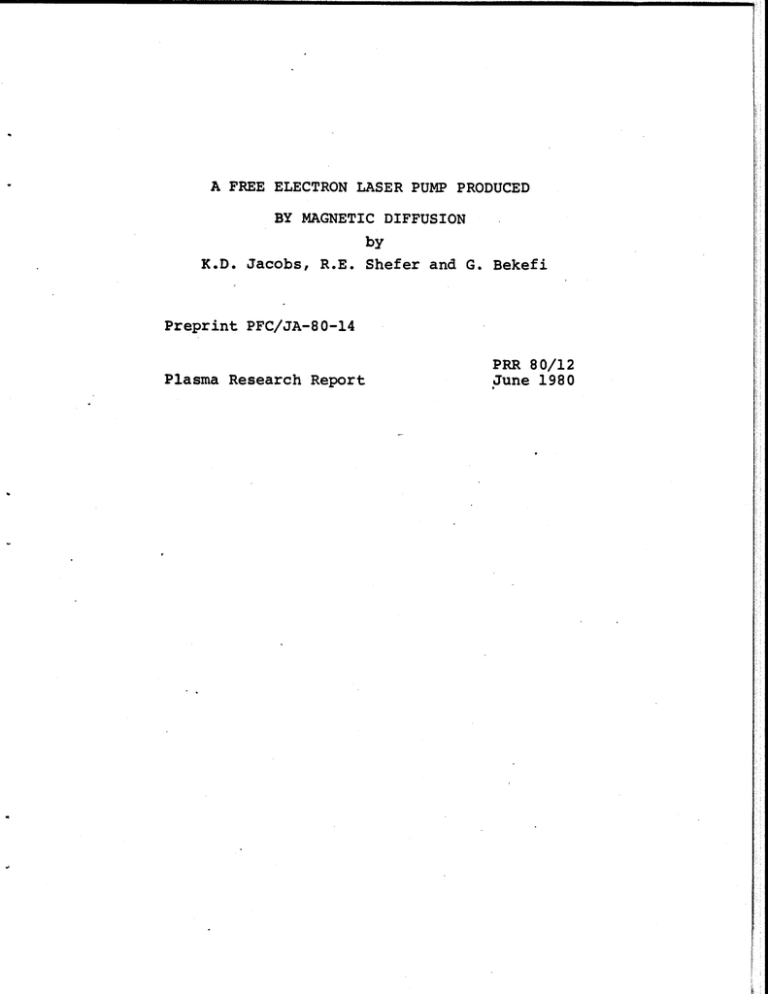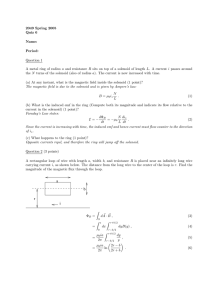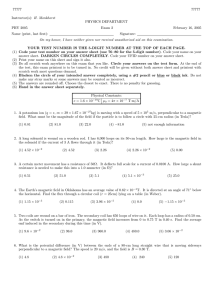K.D. PFC/JA-8 0-14 Plasma Research Report 1980
advertisement

A FREE ELECTRON LASER PUMP PRODUCED BY MAGNETIC DIFFUSION by K.D. Jacobs, R.E. Shefer and G. Bekefi Preprint PFC/JA-8 0-14 PRR 80/12 Plasma Research Report June 1980 - 1 A FREE ELECTRON LASER PUMP PRODUCED BY MAGNETIC DIFFUSION K.D. Jacobs, R.E. Shefer and G. Bekefi Department of Physics and Research Laboratory of Electronics Massachusetts Institute of Technology Cambridge, Massachusetts 02139 ABSTRACT Magnetic diffusion through a spatially periodic assembly of metal conductors yields a large amplitude pump for use in free electron lasers. Experiments and computations which test the performance of the pump are presented. - 2 In a magnetically pumped free electron laserl-4 (FEL), a rel- ativistic electron beam is passed through a quasi-static, spatial- ly modulated magnetic field. Previously, magnetic "wigglers" have been produced by passing current through helical 2 15 ,6 windings or metal rings around the beam drift tube, or by using iron rings 7 to modulate the field of a solenoid. We present here a new method for producing magnetic pumps which uses the principle of magnetic diffusion. In our system the relativistic electron beam propagates down a drift tube surrounded by a solenoid containing a periodic assem- bly of copper rings, separated by plexiglass rings. The solenoid is powered by a capacitor bank which supplies a current pulse in the shape of half a sine wave. Since the copper rings are good electrical conductors, the magnetic field diffuses gradually through them. On the other hand, the plexiglass rings are insula- tors, and the magnetic field penetrates almost instantaneously. Thus, the magnetic field is stronger in a plexiglass ring and weaker in a copper ring. When the solenoid is empty, it produces a uniform, purely axial field, B . z Bz, Putting in the rings introduces a modulation in but in order to keep V-B=O, a radial magnetic field Br is al- so generated. It is this radial field which is used in the FEL interaction. Note, however, that the field in the drift tube is primarily axial and therefore the same solenoid also provides the field which guides the electrons. Figure 1 shows typical oscilloscope traces of the current I passing through the solenoid windings, and the magnetic field com- ponents Br and Bz measured inside the drift tube. The solenoid is - 3 92cm long, has an inner radius of 3.3cm and has 25 turns per cm length. It has an inductance of 30mH, and is driven by a 3.75mF, 4kV capacitor bank. The peak current is 720A, which in the ab- sence of the copper ring assembly produces a peak magnetic field Bz of 21kG. We note that the fields change on a time scale of milliseconds. This means that during the short time (tens of nano- seconds to microseconds) that a typical, pulsed, relativistic electron beam is on, the magnetic fields are essentially constant. Al- so, by varying the time during the magnet pulse at which the beam pulse is turned on, and by varying the charging voltage on the solenoid capacitor bank, the radial field Br and the spatially averaged axial field KBz can be varied at will, independently of one another. Figure 2 illustrates the variation of Br and Bz measured along the length-of the drift tube, at a time during the pulse when the radial magnetic field is the largest. These fields have been measured near the drift tube wall, at a distance r=0.86cm from the solenoid axis. (Due to the cylindrical symmetry of the ring assembly, Br=0 on axis. Thus for FEL applications, an annu- lar electron beam is required.) ple period Z=4cm. The data of Fig. 2 are for a rip- Other periodicities are readily achieved by ar- ranging the rinis in a different order. Measurements for different periodicities are shown in Fig. 3 in which we plot the amplitude of the radial field modulation as a function of k. refer to two different copper ring thicknesses W The two curves (see top of Fig. 2) which we studied for reasons to be discussed momentarily. In an effort to study the dependence of the field modulation on the many variables of the experiment (I, k, W and pulse rise- - 4 time) the following approximate theory has been applied to the problem. Instead of rings inside the solenoid we consider a long hollow copper cylinder of wall thickness W. in the cylinder is calculated8 The current density as a function of radius and time. Then, assuming that the same current density flows in the copper rings, with no current in the plexiglass rings, the Biot-Savart law is used to predict the magnetic field modulation. The results are only in semiquantitative agreement with experiment since we have solved a two dimensional problem by doing a one dimensional calculation. Figure 4 shows the theoretically predicted radial magnetic field modulation B r as a function of the radial thickness of the rings W, for four different ripple periodicities k. As ex- pected, when the wall thickness goes to zero, the modulation goes to zero (there is no diffusion). Likewise, increasing the wall thickness excessively causes the modulation to fall to zero. This is due to the fact that in a pulsed system the eddy currents pene- trate into the rings only a distance on the order of one skin depth. Therefore, for large W, the currents flow far from the drift tube, and the modulation is small. These effects have been verified experi- mentally by changing W as illustrated in Fig. 3. The above experimental and theoretical results are for a peak solenoid current of 720A, and a frequency corresponding to the current risetime of 16Hz. To see the effects of changing the cur- rent risetime, we keep the peak current fixed, and increase the frequency to 160Hz. Calculations show that this causes a 2.5 fold enhancement in the field modulation at an optimum wall thickness W of one skin depth. In an FEL, it is importanti to have the radial field modula- - 5 tion increase gradually from zero, as the beam enters the interaction region, thus, ensuring an adiabatic perturbation of the electrons. This can be achieved by varying the wall thickness W of the first few rings. For example, experiments with a ripple period of 6cm where the first copper ring has a wall thickness of 1.0cm (and all the following rings have 2.1cm thick walls) gives a radial field modulation which gradually increases from zero to its maximum value over a distance of llcm. Instead of using copper rings as the diffusive medium, a copper helix has also been used. This gives a nonzero radial field modulation on axis, and can, therefore, be used as a pump in an FEL where the electron beam is run on axis. For a 6cm period helix, made of a copper bar with a cross section 2cm radially and 3cm axially, the peak field measured on axis is 0.77kG, for full capacitor charging. This is considerably less than has been achieved with rings (see Fig. 2), but no effort has been made to optimize this configuration. In conclusion then, using magnetic diffusion through a periodic assembly of ring conductors, we have a means of producing magnetic pumps for free electron lasers having amplitudes that are comparable to, or greater than those achieved hitherto by other means. changed. Both the ripple period and the ripple amplitude are easily The ring wall thickness W can be readily varied with axial distance, thus assuring that the entering electron beam undergoes adiabatic perturbation. Finally, we note that the diffu- sive system is passive in that the pulsed solenoidal current pro- vides both the guiding magnetic field and the periodic magnetic modulation. - 6 ACKNOWLEDGMENTS This work was supported in part by the U.S. Air Force Office of Scientific Research under Grant AFOSR-77-3143 the Nat-ional Science Foundation under and in part by Grant ENG79-07047. REFERENCES 1. P. Sprangle, R.A. Smith, and V.L. Granatstein, Naval Research Laboratory Report No. 3911, 1978, and bibliography therein. 2. L.R. Elias, W.M. Fairbank, J.M.J. Madey, H.A. Schwettman, and T.I. Smith, Phys. Rev. Lett. 36, 717 (1976); D.A.G. Deacon, L.R.Elias, J.M.J. Madey, G.J. Ramian, H.A. Schwettman, and T.I. Smith, Phys. Rev. Lett. 38, 892 3. (1977). V.L. Granatstein, S.P. Schlesinger, M. Herndon, R.K. Parker, and J.A. Pasour, Appl. Phys. Lett. 30, 384 4. (1977). DB. McDermott, T.C. Marshall, S.P. Schlesinger, R.K. Parker, and V.L. Granatstein, Phys. Rev. Lett. 41, 1368 (1978). 5. B.M. Kincaid, J. Appl. Phys. 48, 6. J.P. Blewett and R. Chasman, J. Appl. Phys. 48, 2692 (1977). 7. P.C. Efthimion and S.P. Schlesinger, Phys. Rev. 16A, 633 (1977); 2684 (1977). R.M. Gilgenbach, T.C. Marshall, and S.P. Schlesinger, Phys. Fluids 22, 971 (1979). 8. For a solid cylinder under sinusoidal excitation, see W.R. Smythe "Static and Dynamic Electricity" (McGraw-Hill 1968) pp 372, 409; our calculations are made for a hollow cylinder and allow for transients. - 7 - CAPTIONS TO FIGURES Fig. 1. Oscilloscope traces of the solenoid current pulse and magnetic field in the presence of periodic ring conductors with 1=4cm, W=2.lcm. The fields are measured at a distance r=0.86cm from the solenoid axis. Fig. 2. The measured axial variation of the magnetic fields at a time during the pulse when Br is maximum; Z=4cm, W=2.lcm and r=0.86cm. Fig. 3. Radial magnetic field amplitude Br measured as a function of ripple periodicity k for two sets of ring structures, having the same inner radii a=1.2cm but different thicknesses W Fig. 4. (see top of Fig. 2). Computed radial magnetic field Br, as a function of wall thickness W for ring structures with different periodici- ties Z. (The inner ring radius a=1.2cm.) 1.2 0.8 -0.4 - - 0 30.8 6 0 -0.8 I I I.... I I I I I I I I I I I I I I 320 N cnIO 0 20 40 TIME (Ms) Fig. 1 Jacobs, Shefer, Bekefi JAOLSENOID __ w -+::--'-:: x-...:x-::k -... ::::.:-: -- :': ::- : .. - -+*..- t COPPER RING-) ....... .---...--........-. F -:- ::: ::::::::::::: :::::.:: ::::::: m SO LE NQI DffA Y (N 0.8 60 T....... ....... ... I -08 A I V 1 A I / 12.0 8.0 l4.0 01 C) 5 I I 10 15 AXIAL DISTANCE z (cm) Fig. 2 Jdcobs, Sheferf Bekefi 2.0 I I I I W=2.l cm 1.5 7 / 0.5 / / / / / / / / / W=l.lcm / 0 I C 2 4 I I 8 6 10 PERIODICITY -Q(cm) Fig. 3 Jacobs, Shefer, Bekefi 1.2 I I I =8cm 1.0 6cm CO .8 C) 0.6 - 4cm z 0.4 0.2 2CmSKIN DEPTH 0' ) I 2 3 WALL THICKNESS W (cm) Fig. 4 Jacobs, Shefer, Bekefi





